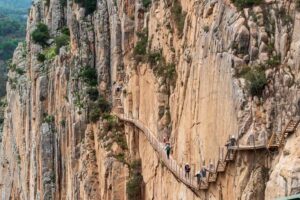Have you ever dreamed of a different experience? In this article, we will look at the unique charm of do the Camino de Santiago in winter. From the magic of snowy landscapes to the challenge of facing the cold, we will guide you through Essential preparations, ideal routes and practical advice to make your trip unforgettable.
Discover how this station transforms the experience into an adventure full of peace, beauty and personal reflection. Get ready to immerse yourself in an experience that goes beyond a simple trip, becoming a true exploration of the soul and nature.
Índice de contenidos
The Camino de Santiago: a brief history
El journey of the road to Santiago It is more than just a trail: it is a set of historical routes that, since the Middle Ages, have attracted pilgrims from all over the world. Its origin dates back to the discovery of the tomb of the apostle Saint James the Greater in the 9th century, which marked the beginning of its religious and cultural importance.
Over the years, the Camino has evolved, adapting to the needs and expectations of modern travelers, without losing its spiritual essence and its rich historical tradition.
Preparations for the Camino de Santiago in Winter
Do the Camino de Santiago in winter requires special preparation, especially with regard to .

The key is to dress in layers: Start with a thermal base that regulates body temperature, followed by a insulating layer to retain heat, and finally, a waterproof outer layer and wind resistant. Don’t forget a hat, gloves and appropriate snow footwear, as keeping your extremities protected is vital.
In terms of health and safety, it is important iFind out about weather conditions Before the trip, always carry a charged mobile phone and a physical map as a backup. Just like in any other season, carrying enough water and energy snacks is essential to stay hydrated and energized during long days of hiking in the cold.
Challenges of the Camino in Winter
Carrying out this adventure during the winter involves overcoming several challenges, being the adverse weather conditions one of the main. Pilgrims can meet snow, heavy rain and extremely low temperatures, especially on elevated routes. These conditions require meticulous preparation and the ability to adapt to unexpected changes.
Another aspect to consider is the lower availability of shelters and services At this time of year. Many establishments close during the winter months, requiring careful planning of accommodations and logistics. However, this can also offer a more peaceful and personal experience on the Camino.
If you want to do the road from Sarria to Santiago There are specialized agencies that can help you with booking accommodation and will also help you with the logistics of the entire pilgrimage.
Routes of the Camino de Santiago ideal for winter
We recommend two routes if you want to do the Camino de Santiago in winter.
- El French Way, departing from Sarria, is a popular option for the winter due to its Relative ease and good availability of services. This 100 km route allows you to experience the essence with varied landscapes. It is ideal for those looking for a complete experience in a limited time.
- Furthermore, the Portuguese Way, especially from Tui, is another accessible route in winter. Less mountainous and with a milder climate Compared to other routes, it offers a peaceful experience, enhanced by the lower influx of pilgrims. It allows for a deeper immersion into the local landscape and culture.
While the Northern route of the Camino de Santiago It is of incomparable natural beauty, given its route along the Cantabrian coast, it is not advisable to do it in winter due to the harsh climate.

Unique experiences of the Camino de Santiago in Winter
The winter season transforms this scene of serene beauty. The snowy landscapes and silent forests They offer a completely different perspective, far from the typical spring or summer images. This natural stillness invites reflection and provides a more contemplative and personal walking experience.
Furthermore, with fewer crowds, the Camino de Santiago in winter becomes a most intimate journey. Pilgrims find more space for themselves, facilitating deeper encounters with both nature and other walkers. This tranquility and lower density of people enrich the experience, turning it into a journey not only physical, but also spiritual.
Tips from experienced travelers
Many pilgrims share valuable tips for those who venture on this route, especially in winter.
First, it is essential choose suitable footwear, preferably waterproof and with good grip to face slippery roads. Also, it is advisable walk during daylight hours to avoid extreme cold at night and possible safety risks.
In addition, carry a first aid kit Well-equipped equipment is essential, including foot care items and basic first aid. Those who have already done so also suggest be flexible with the itinerary, allowing extra days in case weather conditions require changes to the route or additional rest.









